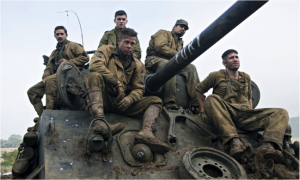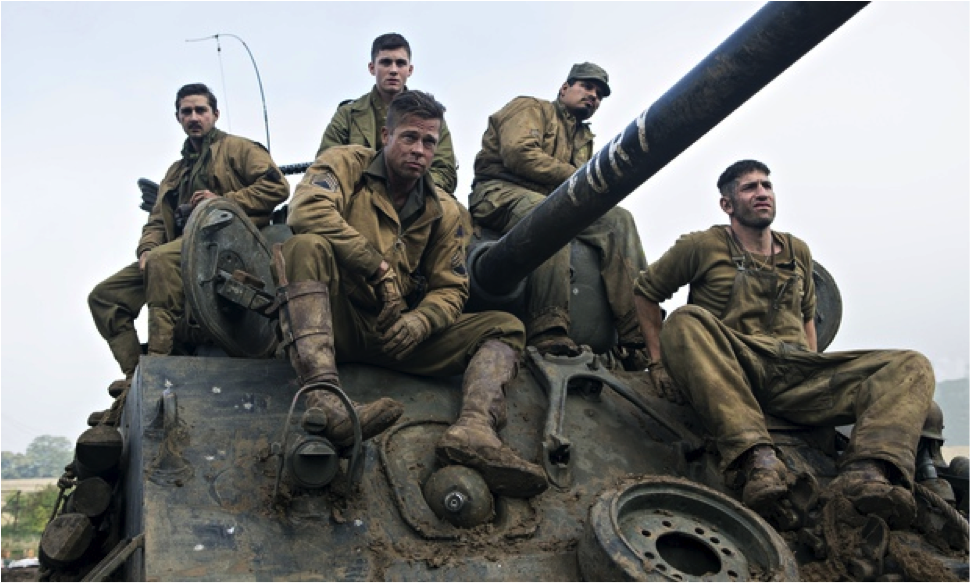By: Rob Oldham
Many times, I walk out of a war film feeling patriotic, proud, and certain that American soldiers are bona fide badasses. Of course I feel this way because that is what a film is designed to do. Everything from the pulse thumping score to the smeared makeup on the actors’ faces is intended to generate emotional reactions in moviegoers. In the case of war films, the intended reaction is typically national pride. “Fury”starring Brad Pitt and Shia LaBeouf bucks this cliché war movie trend by transforming the gruesome horror of the battlefield into a feeling of ambivalence within the viewer. The sentiments we feel tear us between a nostalgic view of the Greatest Generation’s participation in foreign wars and an abysmal hatred for what war really is.
“Fury” is a fictional and maybe exaggerated portrayal of the final months of World War II in Germany. The script follows a tank crew as they face the gritty reality of atrocities, mutilations, and death, not as an instrument of freedom or democracy, but as something that causes untold devastation and ends the existence of many humans well before their time. Unlike war films in the past, “Fury” does not skate around these contentious issues and uses extreme violence as an instrument to show the brutality and ultimate idiocy of war.
One of “Fury’s” admirable qualities is that it does not seek to glorify war. When idealistic newcomer Norman Ellison first joins the crew, he is given the assignment of cleaning out the tank’s interior following an especially brutal battle. Inside the blood soaked hull he finds the charred body and the peeled-off face of the dead crewmember he is replacing. Later on Ellison falls in love with a German girl, who instinctively expects to have to submit to him sexually. She is killed in an artillery strike shortly afterwards. This is a stark reminder that war is not a clean cut affair defined by methodical sniper shots and minimal civilian causalities. Other war films like “Act of Valor”depict a black and white image of heroes facing down villains with well placed shots that make their deaths seem almost humane. It would be unthinkable for a protagonist to harm a civilian. “Fury”throws this simplicity to the wind. War is about tearing a fellow man to shreds. There is nothing clean or humane about it. Civilians are often the victims of atrocities such as murder and rape. It would be a mistake to think that American soldiers are free from this impropriety.
“Fury”also sheds light on the type of people who are put on the front lines. Although popular depictions might show the majority of soldiers as free-thinking, highly-educated, and sensible, this is typically not true. Soldiers are often pulled from lower segments of society. Frequently, the marginalized, the impoverished, and the uneducated are targeted by recruiting campaigns. These are the ones who end up as enlisted men on the front lines. Some of the US Army soldiers in “Fury”are far from noble. They are ruthless thugs. While, this thuggish image should in no way be extended to the average American soldier, especially in the 21st century, it should be realized that soldiers throughout history have been chosen to go to the front lines for a specific reason. It is possibly because they have limited opportunities and little access to education. This is a phenomenon known as the Poverty Draft, where recruiters specifically target low-income areas and use flashy visuals such as movies and video games to convince at-risk youths to join the military. A 2007 Associated Press report revealed that three-fourths of soldiers killed in Iraq up to that point had come from towns with a per-capita income below the national average. Furthermore, in his 2004 presidential campaign John Kerry let slip that students who do not work hard and study “get stuck in Iraq.” Military officials get angry at remarks like Kerry’s and emphasize patriotism as the primary motivation of young soldiers. The truth about why soldiers join the military likely lies somewhere between the extremes of being purely motivated by either patriotism or escaping from poverty. Unlike most war films, “Fury” bravely considers this controversial issue and presents soldiers who are both idealists and those who are motivated by a desire to harm others in order to show that the ethics of the military and soldiers themselves are not so black and white.
Americans are transfixed by the depiction of war in the media, even in the face of protests by the Iraqi Veterans Against the War when the military unveiled their newest recruiting platform, an Army videogame. Protesters reiterated that “war is not a game”, but studies show that the violent media is linked with increased desensitization to violence. Thirteen years of combat in Afghanistan and eight in Iraq combined with a pop culture that is saturated with violence have contributed to Americans’ lack of cognizance about the horrors of war. Moreover, most educated Americans are either draft exempt or too old to have to worry about being sent to war. It is understandable why they might not be thinking about it. “Fury” reminds us of the danger in forgetting exactly what it entails to send troops into battle in order to exterminate an enemy. The process is much more brutal than what can be seen on a popular news show. While I do not intend to condemn American intervention in Iraq or other hotspots across the world, it is important to remind citizens of the weight that dropping bombs on cities, occupying urban areas with armed forces, and pursuing the enemy with every intent of ending their lives carries. It is never as simple or clean as portrayed in popular culture.
“Fury”presents a view of war that most are not comfortable with seeing. It is not only unnatural but also inhumane. David Ayers uses extreme violence to get across his point that war is not something to be celebrated. We should abhor it. However, there is a silver lining and even a glimmer of hope buried within its 135 minute run time. After the final battle scene, a young German soldier sees Ellison, the crew’s lone survivor, hiding under the burned out tank. Rather than alerting his comrades, the young soldier puts an end to the madness of violence that consumed the film’s final act. He simply moves on down the road. There is a silent understanding with Ellison at this point. War is waged between the people of governments or ideologies with opposing views. The government’s actions and their ideological preferences do not necessarily matter to the soldiers. Often, the ones fighting against each other have more in common than the ones they are fighting for.
The scene between Ellison and his German counterpart challenges the idea that humans must always be in constant conflict. Governments may wage wars and mold soldiers, but that does not have to change the simple humanity within each of us. “Fury”depicts the ferocity of war that makes viewers sick to their stomach with the ugliness that has come to define so much of our history. It drives home the idea of what an extreme measure it is to use violence. Only when all possible alternatives have been exhausted should we consider resorting to war, and never should it be taken lightly.


